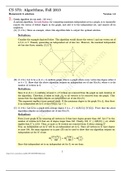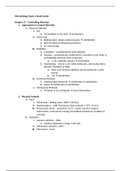Thompson River University (TRU ) • AIT Nursing
Latest uploads for AIT Nursing at Thompson River University (TRU ). Looking for AIT Nursing notes at Thompson River University (TRU )? We have lots of notes, study guides and study notes available for AIT Nursing at Thompson River University (TRU ).
-
46
- 0
- 0
Courses AIT Nursing at Thompson River University (TRU )
Notes available for the following courses of AIT Nursing at Thompson River University (TRU )
-
Nursing Vati_med 46
Latest notes & summaries Thompson River University (TRU ) • AIT Nursing

. Temperature (Section 9.4) • Psychrophiles: prefer cooler temperatures (below 15 degrees C). Do not live in humans. (Psychorotrophs grow at higher temps and can cause spoilage of refrigerated foods). • Mesophiles: prefer 25-40 degrees C. Live in humans as pathogens and non-pathogens. • Thermophiles: prefer 50-60 degrees C. Found in compost piles and hot springs. o Often domain archaea o Often not pathogens to humans Temperature Considerations: • Minimum growth temperatur...
- Other
- • 2 pages's •
-
Thompson River University•Nursing
Preview 1 out of 2 pages
. Temperature (Section 9.4) • Psychrophiles: prefer cooler temperatures (below 15 degrees C). Do not live in humans. (Psychorotrophs grow at higher temps and can cause spoilage of refrigerated foods). • Mesophiles: prefer 25-40 degrees C. Live in humans as pathogens and non-pathogens. • Thermophiles: prefer 50-60 degrees C. Found in compost piles and hot springs. o Often domain archaea o Often not pathogens to humans Temperature Considerations: • Minimum growth temperatur...

• What is the role of oxygen in bacterial metabolism? • What about carbon? • Explain how a low pH affects bacterial metabolism. Shuts down metabolism because it ruins the enzymes that the bacteria need to survive. • Bacteria have varying oxygen requirements. Which category describes those that would grow deep in the soil? o Obligate aerobic- requires oxygen for energy production as an electron acceptor o Facultative anaerobic- can thrive in oxygen but can also use another electron...
- Class notes
- • 3 pages's •
-
Thompson River University•Nursing
Preview 1 out of 3 pages
• What is the role of oxygen in bacterial metabolism? • What about carbon? • Explain how a low pH affects bacterial metabolism. Shuts down metabolism because it ruins the enzymes that the bacteria need to survive. • Bacteria have varying oxygen requirements. Which category describes those that would grow deep in the soil? o Obligate aerobic- requires oxygen for energy production as an electron acceptor o Facultative anaerobic- can thrive in oxygen but can also use another electron...

1. What are the recommendations for nurses that are published in the IOM's report The future of nursing? What is Magnet recognition? a. IOM emphasizes the need for nurses to take the leadership role. b. Professional nurses teach, advocate, assess, and nurture. c. Recommendations: i. Remove scope of practice barriers. ii. Expand opportunities for nurses to lead and diffuse collaborative improvements efforts. iii. Implement nurse residency programs. iv. Increase proportion of nurses wi...
- Exam (elaborations)
- • 6 pages's •
-
Thompson River University•Nursing
Preview 2 out of 6 pages
1. What are the recommendations for nurses that are published in the IOM's report The future of nursing? What is Magnet recognition? a. IOM emphasizes the need for nurses to take the leadership role. b. Professional nurses teach, advocate, assess, and nurture. c. Recommendations: i. Remove scope of practice barriers. ii. Expand opportunities for nurses to lead and diffuse collaborative improvements efforts. iii. Implement nurse residency programs. iv. Increase proportion of nurses wi...

1. Greedy algorithm do not work. (40 pts.) Anaturalalgorithm, GreedyIndep, forcomputingmaximumindependentsetinagraph, istorepeatedly remove the vertex of lowest degree in the graph, and add it to the independent set, and remove all its neighbors. (A) (5 pts.) Show an example, where this algorithm fails to output the optimal solution. Solution: Consider the example depicted below. The algorithm would choose the vertex 1 and one vertex out of 4,5,6, or 7. Namely, generating an independent se...
- Exam (elaborations)
- • 5 pages's •
-
Thompson River University•Nursing
Preview 2 out of 5 pages
1. Greedy algorithm do not work. (40 pts.) Anaturalalgorithm, GreedyIndep, forcomputingmaximumindependentsetinagraph, istorepeatedly remove the vertex of lowest degree in the graph, and add it to the independent set, and remove all its neighbors. (A) (5 pts.) Show an example, where this algorithm fails to output the optimal solution. Solution: Consider the example depicted below. The algorithm would choose the vertex 1 and one vertex out of 4,5,6, or 7. Namely, generating an independent se...

1. Approaches to Control Microbes a. Physical Methods i. Dry 1. incineration or dry oven sterilization ii. Moist heat 1. Boiling water, steam under pressure sterilization 2. Kills microbes by denaturing enzymes 3. Ex. Autoclaving iii. Radiation 1. Irradiation – bombardment with radiation 2. Ionizing – can penetrate a solid barrier, bombard a cell, enter it, and dislodge electrons form molecules a. x-ray, cathode, gamma sterilization 3. Nonionizing – enters a c...
- Exam (elaborations)
- • 7 pages's •
-
Thompson River University•Nursing
Preview 2 out of 7 pages
1. Approaches to Control Microbes a. Physical Methods i. Dry 1. incineration or dry oven sterilization ii. Moist heat 1. Boiling water, steam under pressure sterilization 2. Kills microbes by denaturing enzymes 3. Ex. Autoclaving iii. Radiation 1. Irradiation – bombardment with radiation 2. Ionizing – can penetrate a solid barrier, bombard a cell, enter it, and dislodge electrons form molecules a. x-ray, cathode, gamma sterilization 3. Nonionizing – enters a c...

The Adaptive (Specific) Immune System (Chapter 18) • Adaptive immunity: defenses that target a specific pathogen o Learned- the body has to adapt to this o Some pathogens change their shape so that adaptive immunity misses them • Acquired through infection or vaccination o Immune response is always stronger through infection • Primary response: first time the immune system combats a particular foreign substance • Secondary response: later interactions with the same foreign substan...
- Class notes
- • 4 pages's •
-
Thompson River University•Nursing
Preview 1 out of 4 pages
The Adaptive (Specific) Immune System (Chapter 18) • Adaptive immunity: defenses that target a specific pathogen o Learned- the body has to adapt to this o Some pathogens change their shape so that adaptive immunity misses them • Acquired through infection or vaccination o Immune response is always stronger through infection • Primary response: first time the immune system combats a particular foreign substance • Secondary response: later interactions with the same foreign substan...

. Medications - My 1. Discuss drug legislation in the US - In 1906, the Pure Food and Drug Act designated the United States Pharmacopeia and the National Formulary as the official drug standards in the United States, - in 1938 the Federal Food, Drug and Cosmetic Act prohibited adulterated or mislabeled drugs from being made available.FDA enforces this law. Extensive testing of new drugs is required before marketing. - in 1952 The Durham-Humphrey amendment to the Federal Food, Drug and Cosmet...
- Exam (elaborations)
- • 68 pages's •
-
Thompson River University•Nursing
Preview 4 out of 68 pages
. Medications - My 1. Discuss drug legislation in the US - In 1906, the Pure Food and Drug Act designated the United States Pharmacopeia and the National Formulary as the official drug standards in the United States, - in 1938 the Federal Food, Drug and Cosmetic Act prohibited adulterated or mislabeled drugs from being made available.FDA enforces this law. Extensive testing of new drugs is required before marketing. - in 1952 The Durham-Humphrey amendment to the Federal Food, Drug and Cosmet...

Types of DM 1. Type 1 - severe insulin deficiency resulting in reduction or absence of functioning beta cells in the pancreatic islets of Langerhans. This leads to hyperglycemia due to altered metabolism of lipids, carbs, and proteins. Initial s/s of hyperglycemia. Subjective findings- polyuria, polydipsia, nocturnal enuresis and polyphagia with paradoxical weight loss, visual changes and fatigue. Objective-dehydration(poor skin turgor and dry mucous), wt loss despite normal/increase appet...
- Other
- • 31 pages's •
-
Thompson River University•Nursing
Preview 4 out of 31 pages
Types of DM 1. Type 1 - severe insulin deficiency resulting in reduction or absence of functioning beta cells in the pancreatic islets of Langerhans. This leads to hyperglycemia due to altered metabolism of lipids, carbs, and proteins. Initial s/s of hyperglycemia. Subjective findings- polyuria, polydipsia, nocturnal enuresis and polyphagia with paradoxical weight loss, visual changes and fatigue. Objective-dehydration(poor skin turgor and dry mucous), wt loss despite normal/increase appet...

. Compare and demonstrate the use of the techniques used to measure microbial growth and population size. Bacterial Growth Generation Time (Chapter 9 page 362) • Time required for a cell to divide o 20 minutes to 24 hours • We looked at two ways that this could happen o Binary Fission o Mitosis Bacterial Growth Curve 1. Lag phase: no increase in number of living bacterial cells 2. Log phase: exponential increase in number of living bacterial cells 3. Stationary Phase: plat...
- Other
- • 2 pages's •
-
Thompson River University•Nursing
Preview 1 out of 2 pages
. Compare and demonstrate the use of the techniques used to measure microbial growth and population size. Bacterial Growth Generation Time (Chapter 9 page 362) • Time required for a cell to divide o 20 minutes to 24 hours • We looked at two ways that this could happen o Binary Fission o Mitosis Bacterial Growth Curve 1. Lag phase: no increase in number of living bacterial cells 2. Log phase: exponential increase in number of living bacterial cells 3. Stationary Phase: plat...

Roles and responsibilities of APRN prescribers • The responsibility for the final decision on which drug to use and how to use it is in the hands of the APRN prescriber. • The degree of autonomy in this role and the breadth of drugs that can be prescribed vary from state to state based on the nurse practice act of that state. • All states have title protection for NPs. • Only Oregon has mandated third-party reimbursement parity for NP services. • In all but five states, the cont...
- Essay
- • 33 pages's •
-
Thompson River University•Nursing
Preview 4 out of 33 pages
Roles and responsibilities of APRN prescribers • The responsibility for the final decision on which drug to use and how to use it is in the hands of the APRN prescriber. • The degree of autonomy in this role and the breadth of drugs that can be prescribed vary from state to state based on the nurse practice act of that state. • All states have title protection for NPs. • Only Oregon has mandated third-party reimbursement parity for NP services. • In all but five states, the cont...
